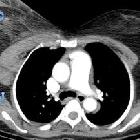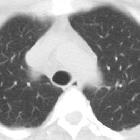Cowden-Syndrom








Cowden syndrome, also known as multiple hamartoma syndrome, is characterized by multiple hamartomas throughout the body and increased risk of several cancers.
Terminology
Type 2 segmental Cowden syndrome is the association of Cowden syndrome with a Cowden nevus when it is considered a type of epidermal nevus syndrome.
Pathology
The disease is characterized by:
- mucocutaneous lesions: present in >90% of cases
- trichilemmomas
- mucocutaneous papillomatous papules
- gastrointestinal hamartomatous polyps (small and large bowel)
- glycogenic acanthosis
- thyroid abnormalities
- thyroid adenomas
- multinodular goiter
- fibrocystic disease of the breast
In addition to benign hamartoma formation, the syndrome carries a recognized increased risk of cancers such as:
- breast cancer: develops in 30-50% of those with the syndrome
- thyroid cancer: develops in 5% of those with the syndrome, usually follicular
- CNS: dysplastic cerebellar gangliocytoma, occurs when in association with Lhermitte-Duclos disease (LDD)
Syndromic associations
Cowden syndrome is part of a group of disease known as PTEN-related diseases, which also includes:
Genetics
It carries an autosomal dominant inheritance with variable penetrance. A gene locus for the disease has been identified on chromosome 10q22-23, a mutation of the PTEN gene.
History and etymology
First described in 1963 by K M Lloyd and M Dennis with the surname of their first patient: Cowden .
Siehe auch:
- fibrozystische Mastopathie
- Hamartom
- Schilddrüsenkarzinom
- Hamartom der Mamma
- Lhermitte-Duclos-Syndrom
- PTEN-Hamartom-Tumor-Syndrom
- Neoplasien der Mamma
- Bannayan-Riley-Ruvalcaba-Syndrom
- Lhermitte-Duclos-Cowden syndrome
und weiter:

 Assoziationen und Differentialdiagnosen zu Cowden-Syndrom:
Assoziationen und Differentialdiagnosen zu Cowden-Syndrom:






